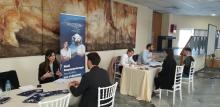Departments Seminar Program (Webinars) - Dr. Konstantinos Pyrgakis (National Technical University of Athens)

Speakers Short CV
Dr. Konstantinos Pyrgakis is Chemical Engineer graduated from the National Technical University of Athens (NTUA). He holds a M.Sc. degree (NTUA) in Computational Mechanics (CFD) and a Ph.D. (NTUA) in the fields of Process Systems Engineering and design of industrial processes; notably in applications for biorefineries, circular economy and industrial networks. His PhD was funded with a scholarship by “Alexander S. Onassis Public Benefit Foundation (Greece)”. He has 13 years of working experience in engineering consultancy and academic research as researcher in NTUA and working in EXELISIS PC, having participated in several national and EU funded research projects. His expertise includes process design, modeling, and optimization; water and energy integration; mathematical programming; techno-economic and Computational Fluid Dynamics (CFD) analysis; pilot unit operations; and fuels and lubricants quality control. He has contributed to the teaching of “Process design” courses in NTUA and is an instructor in the Kapodistrian University of Athens in the fields of “CO2 industry” and “Life Cycle Analysis”. He has 25 scientific publications counting >180 citations and is a reviewer in scientific journals. He is also a Senior Member of AICHE, Associate Member of IChemE, member of the AICHE Computing and Systems Technology Division and member of the Technical Chamber of Greece.
